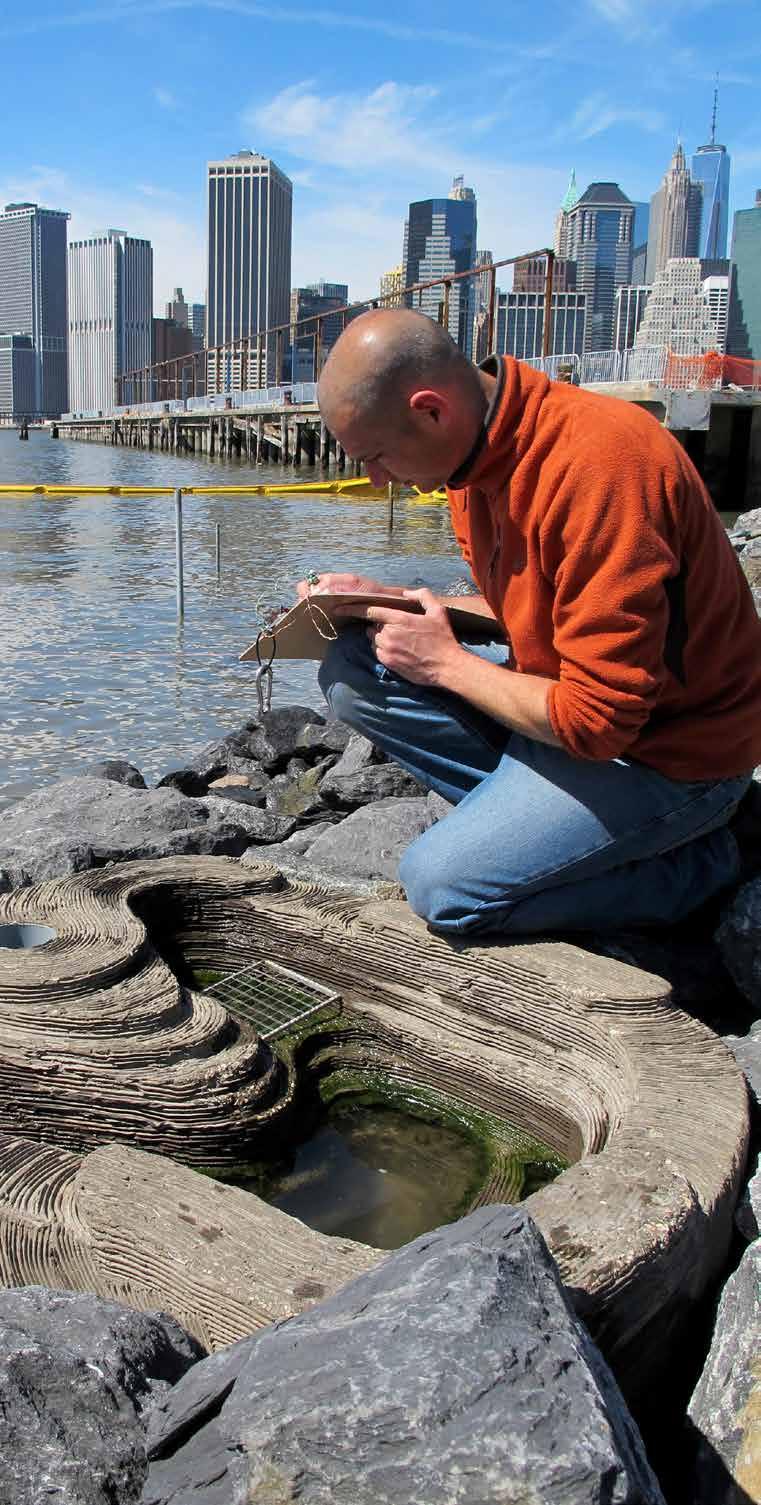
4 minute read
Brooklyn Tide Pools
Brooklyn, New York, United States
Creating intertidal habitat in a postindustrial urban park. Brooklyn Bridge Park in New York City is a popular park with 2 kilometers of revitalized waterfront and 14 hectares of open space. It is a community and tourist destination on the Brooklyn side of the East River, serving thousands of visitors a day. But as a postindustrial urban waterfront, shorelines had declined in recent decades, losing natural intertidal habitats, biodiversity, and biological productivity. Brooklyn Bridge Park Conservancy’s effort to revitalize the park began in 2002, culminating in 2013 with two ECOncrete enhancement projects. The first project features precast concrete tide pools as part of a newly constructed riprap beach at Pier 4, and the second project features the structural repair of the aging piles supporting Pier 6. Using an innovative encasement technology with an ecosystem-specific concrete mix, the physical and chemical changes to the support system created an ecofriendly substrate far superior to standard construction methods. After nine months, the tide pools’ installation showed 89%–100% live cover and increased biodiversity; and after fourteen months, the pile encasements’ installation showed 70%–100% live cover and increased biodiversity. This was a stark contrast to the surrounding riprap and control piles.
Article cover: Underwater survey of piles at 14 month post deployment showing upwards of 70% surface coverage of marine organisms. (Photo by ECOncrete Inc.)
Producing Efficiencies
Integrating environmentally sensitive technologies into the design and construction harnesses natural processes for ecological enhancement and reduces a structure’s ecological footprint. ECOncrete’s design aims to meet the requirements of marine flora and fauna, and the surface complexity mimics that found in natural habitats. These improvements over traditional concrete designs increase native species richness and biodiversity, reduce dominance of invasive species, and encourage water purification. The concrete mixture also lowers the project’s carbon footprint through its low-carbon mix design and the unique ability to enhance biological processes that function as an active carbon sink.
Using Natural Processes
The new tide pools create well-defined elements that retain water and mimic natural rock pools, increasing intertidal habitat in breakwaters, revetments, and riprap. Even though rock armor is made of natural material, its low surface complexity and dense nature provide only limited ecological value to the surrounding environment. These pools replace the standard armoring stones between mean low and mean high water lines, accommodating an array of diverse species typically absent from standard constructions. Finally, the textured surface naturally promotes rich marine growth.

Broadening Benefits
The tide pools and pile encasements increase biodiversity, creating sheltered habitats and nursing grounds. The installations also provide structural and socioeconomic benefits because biogenic growth of organisms like oysters, tube worms, and barnacles strengthens the structure and add to its stability and longevity. This form of bioprotection reduces the frequency and magnitude of structural maintenance, improving ecological stability and saving time and money. The success of both projects increased community awareness through the park’s education program, with local high school students and citizen scientists taking part in the numerous monitoring efforts.

Promoting Collaboration
As a result of the collaborative effort of Brooklyn Bridge Park Conservancy, ECOncrete, and the New York State Department of Environmental Conservation, the Waterfront Alliance has certified the park as a comprehensive, multidisciplinary approach to better waterfront design and adaptive management. The team enhanced the integrity of the structure, improved ecosystem services in an urban marine setting, and increased environmental awareness through public education. The success of these two pilot projects have streamlined the park’s environmental permitting scheme, reducing the need for mitigation requirements for future ecosystem services projects.









